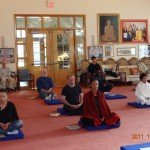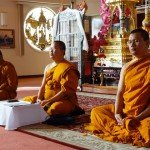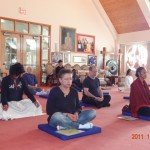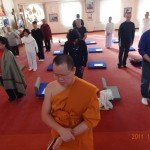
Buddhism is a way of life and living which says something important about the world of today just as it did more than 2,500 years ago when it was first taught by Siddhattha Gotama. It is the way of depending upon oneself. Buddhism does not rest on blind faith but on scientific investigation, on logic, and on reason. It encourages the questioning mind, and it encourages seekers after the highest truth.
The Buddha asked his followers to test the truthfulness of his teaching in the light of their own experience and judgment. When he to some people who doubted him in northeastern India, he advised them not to accept anything on the strength of rumor, simple agreement with one’s own tradition, ideas formed ahead of time, the fact that a person is pleasing to us, rational argument, nor upon the idea, “The monk is our teacher.” On the contrary, he said, “Whatever things are good, whatever things are true, whatever things lead to your own good, these things should you accept, these things should you do.”
Buddhism is not, exactly speaking, a religion at all, as it is not a system of faith and worship owing devotion to any supernatural being. It is a path that guides a seeker through “right” (in the sense of “complete,” “skilful,” “wholesome”) living and thinking to the goal of the highest understanding and deliverance from all “suffering.”
Though flowers, incense, and candles may be offered before pictures or images of the Buddha, he is not worshipped as a god. He was an extraordinary human being, who once said, “He honors me best who practices my teaching best.” Great emphasis is laid on the importance of meditation, which leads to self-discipline, self-control, and Enlightenment. Man follows the way of the Buddhism by his own efforts alone and does not rely on any external power at all. The true Buddhist is full of joy and hope. He follows a teaching which leads to his spiritual freedom, and he recognizes that through his own efforts alone he can reach his goal.
The Buddha. A prince of the warrior class in Aryan society named Siddhattha Gotama who had given up and left his family came down from the lower hills of the Himalaya Mountains to north-central India. After studying and refusing to accept the philosophical systems that were then being taught, he reached Enlightenment by his own efforts: he become the Buddha, the “Enlightened One.” Modern writers of history agree that this happened in or about 525 B.C. at Bodh-Gaya in Bihar, a state in northeastern India. From there Gotama journeyed to Varanasi where, at the time of the full moon in July, he gave his famous first discourse and thus “set in motion the Wheel of the Law.” He worked without ceaselessly for the good and happiness of the many and passed away at the age of eighty, leaving no one to take over for him but encouraging his followers to consider the Dhamma as their teacher.
The Buddha’s Teaching. The teachings (Dhamma) of the Buddha have come to be known as Buddhism, and at one time they were in full force throughout Asia. During twenty-five centuries, Buddhism has combined with the traditional beliefs and religions of many lands, making them more valuable because of the purity of its philosophy. Thus in modern times there about four hundred million Buddhists in the world, found mainly in India, China, Taiwan, Siberia, Japan, Tibet, Korea, Thailand, Vietnam, Cambodia, Laos, Myanmar (Burma), Sri Lanka, Malaysia, and Singapore, with large groups in Western countries, especially England, France, West Germany and the United States.
Beginning his first discourse, the Buddha asked his followers to avoid the extremes of sensual desire and self-mortification (punishing oneself). He said, “Sensual desire is low, common, and improper, not noble, and unprofitable; and self-mortification is painful, not noble, and unprofitable.” He said this because sensual desire slows down one’s spiritual progress, and self-mortification weakens one’s power of understanding.
The Buddha himself put into practice both these extremes before his Enlightenment, the first when he was a prince in his father’s house before he gave up and left the world, the second as an ascetic in the forest before his Enlightenment. Hence he realized their uselessness and discovered that only overcoming oneself in moderation leads to the highest goal of nibbana or nirvana, that is, Enlightenment.
The Four Noble Truths. Avoiding the two extremes, the Buddha, therefore, asked his followers to take the Middle Way, which “opens the eyes and gives understanding, which leads to peace of mind, to the higher wisdom, to full Enlightenment.” In fact, according to the First Noble Truth, life is subject to “suffering.” This is the quotation that fits here: “Now this is the noble truth of suffering: birth is suffering, falling into a lesser condition is suffering, sickness is suffering, death is suffering, connection with things one dislikes is suffering, separation from things one likes is suffering, not to get what one wants is suffering. In short, the five aggregates of clinging are suffering.”
When these conditions are analyzed one by one, we can see how painful they are. Every one of us has to face these conditions in his journey through life. Impermanence is a fact that applies to everything. There is nothing born or conditioned which is not subject to this law. Hence the logic of the Buddha’s saying that whatever is impermanent is also painful. Thus even the so-called pleasures end in pain. This proves the truth of the statement that all conditions of life based on attachment are painful.
The Second Noble Truth is that this suffering is caused by ignorance which results in desire. All things and events are related as causes and effects.
There is nothing in the world as it appears to us which falls outside the cause-effect relation. So, like everything else, suffering has its cause, and that cause is found not outside us but within us. Now what is that cause? It is self-centered desire. Selfish desires are based on valuing everything in relation to oneself and show themselves in different forms: arguing, fighting, etc.
The Third Noble Truth is that this suffering can be gotten rid of by the removal of desire. We now know that selfish desire is the cause of suffering. When the cause is removed, the effect will naturally cease. When desire is destroyed, suffering will also come to an end. The end of suffering is the negative result, and reaching the bliss of Enlightenment is the positive result. In other words, along with reaching Enlightenment there will be an end to all suffering.
The Fourth Noble Truth is the path to get rid of suffering. One can, therefore, put an end to suffering by choosing as one’s own and following the path, the Middle Way, which for the Buddhist is the philosophy of life itself. The Middle Way of overcoming oneself which leads to the highest goal has eight parts.
This is the Noble Eightfold Path:
1) Right Understanding,
2) Right Thought,
3) Right Speech,
4) Right Action,
5) Right Livelihood,
6) Right Effort,
7) Right Mindfulness,
8) Right Concentration.
The whole teaching of the Buddha, to which he devoted himself for 45 years, deals with this Path. Buddha explained the Dhamma in different ways with different words to different people, according to the stage of their development and their capacity to understand and follow him, but the essence of those many thousand discourses scattered hi the Buddhist Scriptures are found hi the Noble Eightfold Path and summarized hi the Threefold Doctrines namely;
1. Not to do bad
2. To do good, and
3. To purify the mind from its impurities or mental defilement
The eight factors aim at promoting and perfecting the three essentials of the Buddhist training and discipline:
1. Moral Conduct (Sila),
2. Mental Discipline (Samadhi),
3. Wisdom (Panna).
Moral Conduct:
Moral conduct is the basic principle of Buddhism for the training and developing of an ordinary person to become a perfect human being. It consists of commitment to (1) avoid killing and harming living beings while trying to develop loving-kindness and compassion; (2) avoid taking what is not given while trying to develop sincerity and respect for ownership and the possessions of others; (3) avoid sexual misconduct while trying to develop honesty and respect toward the opposite sex; (4) avoid false speech while trying to develop truthfulness and sincerity; (5) avoid taking intoxicating drink and harmful drugs while trying to develop mindfulness and awareness in daily life.
Mental Discipline:
When we develop moral conduct, we are certain to have peaceful family and peaceful society, and then we are ready to go for meditation practice for more training in mental culture. Mental culture develops the human mind to become a noble being and finally to become a perfect noble one through wisdom training. There are two lands of mental culture, namely; Concentration meditation (Samatha Bhavna) and Insight meditation (Vipassana Bhavna). The details of meditation practice we will discuss and practice together later on.
Wisdom Training:
Wisdom is the way to see the ultimate truth of reality. When the mind of the meditation practitioner becomes calm, dear and peaceful, he or she may apply peaceful mind to look at the ways of all thing visible and invisible as they really are. Their ways are as follows;
1) Impermanence means that nothing in this world is permanent. Everything that we see around us seems the same but is actually in a state of constant flow. The flowers that bloom today will dry up tomorrow. Impermanence is a law of the universe which nothing can escape, from the stars and plants to the smallest living things on earth.
2) Suffering is the second of the main characteristics of existence. The word dukkha is translated into English as suffering, sorrow, or unsatisfactoriness. The First Noble Truth can be summed up in this one word. The cause of suffering, as seen in the Second Noble Truth, is desire—the craving for sensual pleasures, for existence, or for self-destruction. By the complete removal of desire by man’s own conscious efforts, the Buddha taught that man can reach absolute peace and bliss, Enlightenment. The Buddha taught the existence of suffering, but he also taught the way out of suffering. He not only determined what the sickness is, but he also described a practical cure—the practice of the Eightfold Noble Path. “This above all do I teach,” he said, “suffering and the way out of suffering.”
3) No-self is the teaching that there is no permanent being in man which can be called a self or soul. The so-called “self” or “I” is made up of five groups of attachment, the five aggregates. These are body, sensations, perceptions, intentional activities, and consciousness. Just as the word house is but a way of taking about bricks, wood, and other building materials, even though in the truest sense there is in reality no one separate thing that is a house, so in exactly the same way the words living being and ego are but ways of talking about the five groups of attachment.
The value of understanding the three characteristics of existence lies in progress made toward lessening one’s attachment to material objects, mental concepts, and the existence of the senses in general. In this way we go beyond avoidable suffering and unhappiness.
When the mind understands the way of everything as it really is, the mind does not cling and does not attach to anything one will see and view all things with a realistic approach. At that level of meditation the mind becomes free from all kinds of mental defilement, becoming a mind that can be called free mind, independent mind, perfect mind or enlightened mind. The person who lives with this mind will always live his or her life in peace and happiness here and now, not waiting until after death. This is what the Buddha taught and the goal of Buddhism.

















